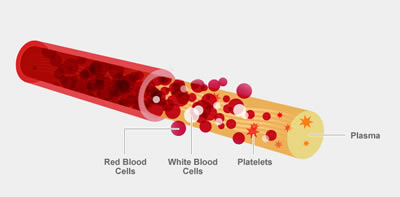Difference between Blood and Plasma
Key Difference: Blood is a bodily fluid that serves a variety of purposes in the body. It is part of the circulatory system of the body, the center of which is the heart. The blood is made up of the red blood cells, white blood cells, and blood platelets all of which float in blood plasma. In the most basic terms plasma is basically what is left of the blood after the red blood cells, white blood cells, and blood platelets have been removed from it.

Blood is a bodily fluid that serves a variety of purposes in the body. It is part of the circulatory system of the body, the center of which is the heart. The heart pumps the blood to various parts of the body. The blood in turn helps transport necessary nutrients and oxygen to the cells in the various parts of the body. The blood also helps in the removal of waste products and carbon dioxide that the cells have produced. Blood also plays a major part in regulating temperature, pH balance, and water balance.
An average human being has about 5 liters of blood in their body, which constitutes for about 7% of the human’s body weight. The blood is created in the bone marrow, which is the inner soft part of the bone. It is made up of three different components: red blood cells, white blood cells, and blood platelets. The red blood cells are the ones that carry the oxygen, nutrients, waste products and carbon dioxide. The white blood cells are the ones that fight off infections and help heal wounds. The blood platelets help the blood to clot.
The red blood cells, white blood cells, and blood platelets all float in blood plasma. Blood plasma is the liquid that carries the different components of the blood around, hence allowing them to do their job. About 55% of the blood is plasma, the rest constituting the other three. Hence, out of the 5 liters of blood, about 3 liters are plasma. Plasma in turn is mainly water, which makes up about 90% of plasma.
 After the removal of the red blood cells, white blood cells, and blood platelets, the plasma appears to be yellowish is color, as blood gets its red coloring from the red blood cells. The plasma is an important part of the blood, as it allows the cells to transport from one place to another. The plasma also contains various dissolved proteins, glucose, clotting factors, antibodies, mineral ions, hormones and carbon dioxide. Plasma is the transport medium for excretion, which basically means that it allows the cells to move waste products from one place to the other to be disposed of. Plasma also plays an important role as the protein reserve of the human body, due to the various dissolved proteins. Also, plasma protects the body from infection and other blood disorders, as well as helping to keep electrolytes in a balanced form. It also plays an important part in maintaining the proper pH balance in the body.
After the removal of the red blood cells, white blood cells, and blood platelets, the plasma appears to be yellowish is color, as blood gets its red coloring from the red blood cells. The plasma is an important part of the blood, as it allows the cells to transport from one place to another. The plasma also contains various dissolved proteins, glucose, clotting factors, antibodies, mineral ions, hormones and carbon dioxide. Plasma is the transport medium for excretion, which basically means that it allows the cells to move waste products from one place to the other to be disposed of. Plasma also plays an important role as the protein reserve of the human body, due to the various dissolved proteins. Also, plasma protects the body from infection and other blood disorders, as well as helping to keep electrolytes in a balanced form. It also plays an important part in maintaining the proper pH balance in the body.
Plasma is an important part of the blood, without which the cells i.e. red blood cells, white blood cells, and blood platelets, will not be able to do their jobs, which means that the cells of the body will not be able to do their job. In the most basic terms plasma is basically what is left of the blood after the red blood cells, white blood cells, and blood platelets have been removed from it.
Comparison between Blood and Plasma:
|
|
Blood |
Plasma |
|
Description |
Blood is a reddish fluid that is part of the circulatory system that helps transport oxygen and nutrients to the cells and the removal of waste from those cells. |
Plasma is part of the blood, making up about 55% of the blood volume. Plasma helps transport the red blood cells, white blood cells, and blood platelets so that they can do their job. |
|
Part of |
The circulatory system |
Blood, which is part of the circulatory system |
|
Made up of |
|
|
|
Color |
Red, due to presence of red blood cells. |
Straw-yellow, as the red blood cells which give the blood its color have been removed. |
|
Function |
|
|
Image Courtesy: americasblood.org, kidzworld.com









Add new comment